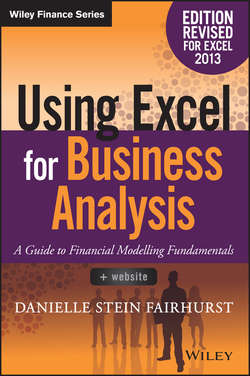Читать книгу Using Excel for Business Analysis - Fairhurst Danielle Stein - Страница 6
На сайте Литреса книга снята с продажи.
CHAPTER 1
What Is Financial Modelling?
WHAT’S THE DIFFERENCE BETWEEN A SPREADSHEET AND A FINANCIAL MODEL?
ОглавлениеLet me make one thing very clear: I am not partial to the use of the word spreadsheet; in fact, you’ll hardly find it used at all in this book.
I’ve often been asked the difference between the two, and there is a fine line of definition between them. In a nutshell, an Excel spreadsheet is simply the medium that we can use to create a financial model.
At the most basic level, a financial model that has been built in Excel is simply a complex spreadsheet. By definition, a financial model is a structure that contains input data and supplies outputs. By changing the input data, we can test the results of these changes on the output results, and this sort of sensitivity analysis is most easily done in an Excel spreadsheet.
One could argue then, that they are in fact the same thing; there is really no difference between a spreadsheet and a financial model. Others question if it really matters what we call them as long as they do the job. After all, both involve putting data into Excel, organising it, formatting, adding some formulas, and creating some usable output. There are, however, some subtle differences to note:
1. “Spreadsheet” is a catch-all term for any type of information stored in Excel, including a financial model. Therefore, a spreadsheet could really be anything – a checklist, a raw data output from an accounting system, a beautifully laid out management report, or a financial model used to evaluate a new investment.
2. A financial model is more structured. A model contains a set of variable assumptions, inputs, outputs, calculations, scenarios, and often includes a set of standard financial forecasts such as a profit and loss, balance sheet, and cash flow, which are based on those assumptions.
3. A financial model is dynamic. A model contains variable inputs, which, when changed, impact the output results. A spreadsheet might be simply a report that aggregates information from other sources and assembles it into a useful presentation. It may contain a few formulas, such as a total at the bottom of a list of expenses or average cash spent over 12 months, but the results will depend on direct inputs into those columns and rows. A financial model will always have built-in flexibility to explore different outcomes in all financial reports based on changing a few key inputs.
4. A spreadsheet is usually static. Once a spreadsheet is complete, it often becomes a stand-alone report, and no further changes are made. A financial model, on the other hand, will always allow a user to change input variables and see the impact of these assumptions on the output.
5. A financial model will use relationships between several variables to create the financial report, and changing any or all of them will affect the output. For example, Revenue in Month 4 could be a result of Sales Price × Quantity Sold Prior Month × Monthly Growth in Quantities Sold. In this example, three factors come into play, and the end user can explore different mixes of all three to see the results and decide which reflects his or her business model best.
6. A spreadsheet shows actual historical data, whereas a financial model contains hypothetical outcomes. A by-product of a well-built financial model is that we can easily use it to perform scenario and sensitivity analysis. This is an important outcome of a financial model. What would happen if interest rates increase by half a basis point? How much can we discount before we start making a loss?
In conclusion, a financial model is a complex type of spreadsheet, whilst a spreadsheet is a tool that can fulfill a variety of purposes – financial models being one. The list of attributes above can identify the spreadsheet as a financial model, but in some cases, we really are talking about the same thing. Take a look at the Excel files you are using. Are they dynamic, structured, and flexible, or have you simply created a static, direct-input spreadsheet?
